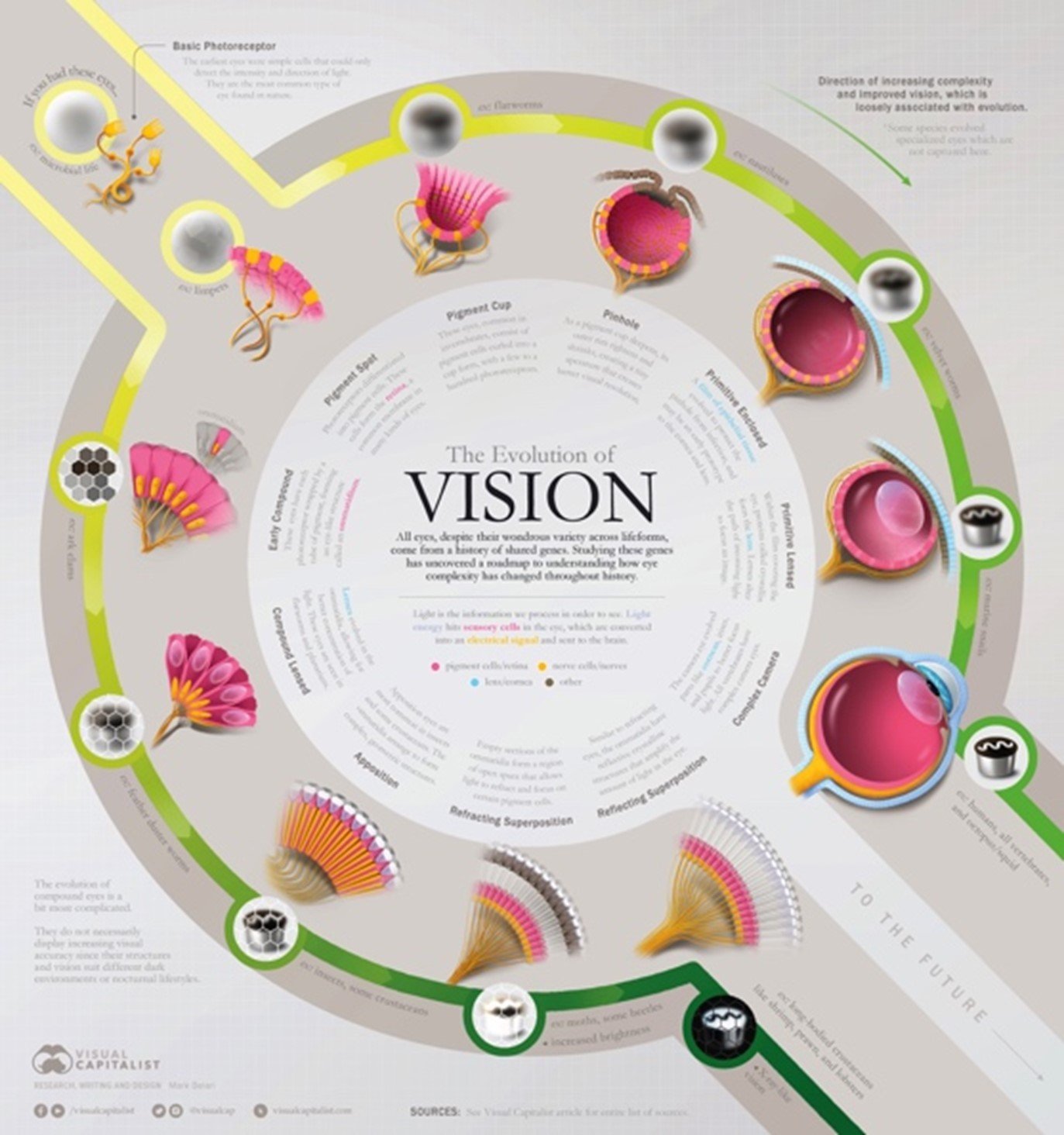Darwin’s Challenge: The Origins of the Eye
The design of the eye in various living things defies evolutionary explanation.
Throwing Down the Gauntlet
Evolutionists attempt to establish roadmaps of the evolution of various lifeforms or certain aspects of them. The eye is no exception. Indeed, the famous quote of Darwin regarding the apparent absurdity that such a complex organ could arise by natural selection seems to challenge both evolutionists and creationists to make their case regarding the origins of the eye.
To suppose that the eye, with all its inimitable contrivances for adjusting the focus to different distances, for admitting different amounts of light, and for the correction of spherical and chromatic aberration, could have been formed by natural selection, seems, I freely confess, absurd in the highest degree.
Darwin goes on to specify the details of the challenge: if only there were an evidential roadmap leading from simple and imperfect eyes to complex and perfect ones—with each gradation being useful to its possessor—then, surely, the so-called theory of evolution will have been validated.
Reason tells me, that if numerous gradations from a simple and imperfect eye to one complex and perfect can be shown to exist, each grade being useful to its possessor, as is certainly the case; if further, the eye ever varies and the variations be inherited, as is likewise certainly the case; and if such variations should be useful to any animal under changing conditions of life, then the difficulty of believing that a perfect and complex eye could be formed by natural selection, though insuperable by our imagination, should not be considered as subversive of the theory.1
And so, the hunt was on.
A Running Battle

Figure 1. One supposed timeline of eye evolution.3
For decades, the scientific community has been publishing papers on the supposed evolution of the eye, attempting to make such a case (see Figure 1).2,3,4 Creationist scientists have shown the problems with the various evolutionary hypotheses.5,6,7
In 2016, National Geographic published an article titled, “Inside the Eye: Nature’s Most Exquisite Creation,” reporting on the work of Dan-Eric Nilsson.8 This article did its best to meet the criteria of Darwin’s challenge. In an Answers in Genesis response to this publication, Dr. Elizabeth Mitchell pointed out that “when [eyes are] lined up according to complexity, they form a sequence that—according to evolutionists—affirms the prophetic power of Darwinian thought.” The author of the National Geographic article, Ed Yong, makes just such a claim: “Living animals illustrate every possible intermediate between the primitive light-sensitive patches on an earthworm and the supersharp camera eyes of eagles.” The problem is that this living evidence isn’t quite what Darwin had prophesied.
Left Scratching Their Heads
According to The Origin of Species,1 Darwin predicted that “in all cases the new and improved forms of life will tend to supplant the old and unimproved” and that “the principle of competition between organism and organism, between child and parent, will render [the survival of one form for a very long period unaltered] a very rare event.” This original evolutionary concept has become known as phyletic gradualism.9
However, Darwin himself questioned, “Why then is not every geological formation and every stratum full of such intermediate links? Geology assuredly does not reveal any such finely graduated organic chain.” Darwin’s protégés have continued to struggle to discover that finely graduated organic chain and thus proposed alternative means: punctuated equilibrium. This theory suggests that evolutionary development is marked by isolated episodes of rapid speciation between long periods of little or no change, often in response to a speciation event such as dramatic climate change. In such a case, the change is favorable to survival, thus theoretically supplanting its predecessor and culminating in the superior organ or organism. Yet, in the case of the eye, here they are—all lined up, from “simple” to “complex.” They exist in the fossil record, and they remain today. Rather than evolving, it’s almost as if they were each designed to suit the organism for which they were designed, in the environment in which they live. And that design has stood the test of time—they are all still working!
Much Ado About Nothing

Figure 2. Example of simulated steps in eye evolution.10
Yong goes on to say that Nilsson has shown that the former could evolve into the latter in a surprisingly short amount of time. However, the original article10 actually shows that he can create a contrived simulation where all these transitions occur over a supposed 364 million years. He depicts the various transitions without explaining how the changes occurred or where the new information came from (Figure 2, right). Still, having at least theoretically fulfilled the required evidential roadmap (sans evidence), the author of the National Geographic article goes on to assure the reader that these various stages were useful to their possessors (sans evidence), thus attempting to address Darwin’s remaining criterion.
Calling Their Bluff
In a well-written and detailed rebuttal to Nilsson’s article in 2016, Dr. Mitchell addresses the weaknesses in their arguments, differentiates between observation and conjecture, and responds to the supposed “flaws” of the human eye that they identify.
Mitchell points out that what they have conjured up has never actually been observed: “The ability to simulate something on a computer is no guarantee that it can happen in living organisms, much less that it happened in billions of living organisms over millions of unobservable years. The insurmountable problem is, from a biological standpoint, that there is no experimentally demonstrable way to get from one step to the next.”
Furthermore, while evolutionists often argue that the human eye is flawed, she notes the brilliant design features that explain or address the supposed “flaws.” For example, Yong argues that “our retinas are bizarrely built back to front. The photoreceptors sit behind a tangled web of neurons.” However, Mitchell explains that this is actually a strategic positioning of the various components of the eye that allows for the cleanup of toxic by-products generated by interaction with light. The positioning of the pigmented epithelium and the blood supply to the retina are right beside the photoreceptors where the toxic molecules and free radicals are generated.
As to the “poorly designed” blind spot: God strategically offset the placement of the optic nerve, away from the focal point, and gave us two eyes that completely compensate for any vision lost in the region where the neurons exit the eye via the optic nerve. You can read more in her original article, “Does the Diversity of Eyes in Nature Support Evolution?”
Artful Deception

Figure 3. Recent visualization of supposed evolution of eyes and sight.11
A recent article from Visual Capitalist, “Visualizing the Evolution of Vision and the Eye,”11 similarly lays out a very beautiful illustration of how simple and compound eyes have supposedly evolved over time (Figure 3, right). In a linear timeline that diverges into two separate paths, it shows the “evolution” of simple eyes (which they admit are far from simple) seemingly gaining increasing complexity and visual acuity as it rounds the corner of time in one lane, with the apparent “evolution” of compound eyes depicted in the other. The two lanes converge at what appears to represent present time with a single lane projecting into a nebulous future. It’s conceptually beautiful . . . and seemingly convincing.
The Devil Is in the Details
This neat progression of eyes from simple to complex is not as uncomplicated as it may seem at first glance. A close examination of their own narrative shows that the illustration that so beautifully seems to fulfil Darwin’s challenge actually falls woefully short. Rather than evolutionary steppingstones, the various eyes along their fictitious timeline are cherry-picked representatives from across the spectrum of life, selecting them—and then illustrating them—in a manner that conveys the illustrator’s simple-to-complex storyline. However, in an almost imperceptible small, gray font on an only slightly lighter gray background, you find a caveat in each corner of the diagram.
Regarding the simple eyes, they note: “Some species evolved specialized eyes not captured here.” It would be interesting to see how their visual story might have been complicated by those “specialized eyes.” They chose to leave them out.
Regarding the compound eyes, they note: “They do not necessarily display increasing visual accuracy since their structures and vision suit different dark environments or nocturnal lifestyles.” Yet they chose to leave these in—strategically organizing them from “simple” to “complex,” though there’s really nothing at all simple about even the supposedly simplest specimens.
It would appear that they chose examples that would make a pretty, storybook illustration rather than trying to give the whole, messy (for them), complicated picture of reality. Perhaps the data doesn’t really support such a linear progression toward Darwin’s prophesy after all.
Divided Camp
The illusion of a linear progression of complexity culminating with the camera eye is challenged from within their own ranks. Within days of the Visual Capitalist article, researchers at the University of Oregon published their findings on the organizational logic of the octopus visual system.12 The resulting neurological map presented details regarding the neural circuits used for vision in octopi, which they espouse to be useful in understanding the evolution of visual processing. What they propose, however, is that even though the previous author would have the octopus and humans sharing the same eye icon on their roadmap through time, the Oregon researchers claim the octopus would have merged in from a completely different lane via convergent evolution.13
So, even as one evolutionist espouses the linear trajectory of evolution, a single highway, others espouse a complex network of pathways somehow arriving at the same solution, like the loops and overpasses at the intersection of multiple highways and interstate roadways. Indeed, there are those who would say that the eye has arisen through convergent evolution as many as 40 times, or more!14
The Visual Capitalist uses creative graphics to convey a main point. And they do it well! They presented the information to their readers in a way that tells their story convincingly. But they do so by eliminating inconvenient information and by presenting the remaining information in a way that does not reflect reality.
Hold Your Own
God’s good design of the eye is further explained in “The Seeing Eye,” “The Human Retina Shows Evidence of Good Design,” “Didn’t Darwin Call the Evolution of the Eye Absurd?,” “The Human Retina Shows Evidence of Good Design,” and “Darwin vs. the Eye.” Find these and other articles on our website and find additional books and resources in our online store. Answers in Genesis is continually producing materials covering many fields of science and many other important topics.
We can combat misinformation in this area by becoming informed and able to spot and explain evolutionary deception, such as this just-so story, to others. In this way, we can be “prepared to make a defense to anyone who asks you for a reason for the hope that is in you” (1 Peter 3:15).
Footnotes
- Charles Darwin, On the Origin of Species, (London, UK: John Murray, 1859).
- G. Halder, P. Callaerts, W. J. Gehring, “New perspectives on eye evolution,” Current Opinion in Genetics & Development 5, no. 5 (1995): 602–609, https://doi:10.1016/0959-437X(95)80029-8, PMID 8664548.
- T. D. Lamb, E. N. Pugh, S. P. Collin, “The Origin of the Vertebrate Eye,” Evolution: Education and Outreach 1 (2008): 415–426, https://doi.org/10.1007/s12052-008-0091-2.
- Dan-Eric Nilsson, “Eye Evolution and Its Functional Basis,” Visual Neuroscience 30, no. 1–2 (March 2013): 5–20, https://doi.org/10.1017/S0952523813000035, PMID 23578808, PMCID PMC3632888.
- Jerry Bergman, “Did Eyes Evolve by Darwinian Mechanisms,” Journal of Creation 22, no. 2 (August 2008): 67–74.
- David Menton, “The Seeing Eye,” Answers Magazine (Jul–Sep 2008): 76–79.
- Tom Wagner, “Darwin vs. The Eye,” Creation 16, no. 4 (September 1994): 10–13.
- Ed Yong, “Inside the Eye: Nature’s Most Exquisite Creation,” National Geographic (January 2016), http://ngm.nationalgeographic.com/2016/02/evolution-of-eyes-text.
- Monalie C. Saylo, Cheryl C. Escoton, Micah M. Saylo, “Punctuated Equilibrium vs. Phyletic Gradualism,” International Journal of Bio-Science and Bio-Technology 3, no. 4 (December 2011): 27–41.
- Dan-Eric Nilsson and S. Pelger, “A Pessimistic Estimate of the Time Required for an Eye to Evolve,” Proceedings of the Royal Society B: Biological Sciences 256, no. 1345 (1994), https://doi.org/10.1098/rspb.1994.0048.
- Mark Belan, “Visualizing the Evolution of Vision and the Eye,” Visual Capitalist, November 4, 2022, accessed November 21, 2022, https://www.visualcapitalist.com/eye-evolution/.
- Jeremea O. Songco-Casey et al., “Cell Types and Molecular Architecture of the Octopus bimaculoides Visual System,” Current Biology 32 (December 2022): 1–14, https://doi.org/10.1016/j.cub.2022.10.015.
- Convergent evolution is the idea of different organisms independently evolving similar traits. For example, sharks and dolphins looking relatively similar despite being entirely unrelated. See “Convergent Evolution or Common Designer?”
- Russell D. Fernald, “Evolution of Eyes,” Current Opinion in Neurobiology 10, no. 4 (August 2000): 444–450, https://doi.org/10.1016/s0959-4388(00)00114-8, PMID 10981612.

Answers in Genesis is an apologetics ministry, dedicated to helping Christians defend their faith and proclaim the good news of Jesus Christ.
- Customer Service 800.778.3390
- Available Monday–Friday | 9 AM–5 PM ET
- © 2025 Answers in Genesis




